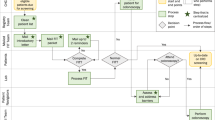Abstract
Purpose
Clinical pathways (CP) are nowadays used in numerous institutions, but their real impact is still a matter of debate. The optimal design of a clinical pathway remains unclear and is mainly determined by the expectations of the individual institution. The purpose of the here described pilot project was the development of two CP (colon and rectum carcinoma) according to Business Process Modeling Notation (BPMN) and Tangible Business Process Modeling (t.BPM).
Methods
BPMN is an established standard for business process modelling in industry and economy. It is, in the broadest sense, a computer programme which enables the description and a relatively easy graphical imaging of complex processes. t.BPM is a modular construction system of the BPMN symbols which enables the creation of an outline or raw model, e.g. by placing the symbols on a spread-out paper sheet. The thus created outline can then be transferred to the computer and further modified as required. CP for the treatment of colon and rectal cancer have been developed with support of an external IT coach.
Results
The pathway was developed in an interdisciplinary and interprofessional manner (55 man-days over 15 working days). During this time, necessary interviews with medical, nursing and administrative staffs were conducted as well. Both pathways were developed parallel. Subsequent analysis was focussed on feasibility, expenditure, clarity and suitability for daily clinical practice. The familiarization with BPMN was relatively quick and intuitive. The use of t.BPM enabled the pragmatic, effective and results-directed creation of outlines for the CP. The development of both CP was finished from the diagnostic evaluation to the adjuvant/neoadjuvant therapy and rehabilitation phase. The integration of checklists, guidelines and important medical or other documents is easily accomplished. A direct integration into the hospital computer system is currently not possible for technical reasons.
Conclusion
BPMN and t.BPM are sufficiently suitable for the planned modelling and imaging of CP. The application in medicine is new, and transfer from the industrial process management is in principle possible. BPMN-CP may be used for teaching and training, patient information and quality management. The graphical image is clearly structured and appealing. Even though the efficiency in the creation of BPMN-CP increases markedly after the training phase, high amounts of manpower and time are required. The most sensible and consequent application of a BPMN-CP would be the direct integration into the hospital computer system. The integration of a modelling language, such as BPMN, into the hospital computer systems could be a very sensible approach for the development of new hospital information systems in the future.





Similar content being viewed by others
References
Ronellenfitsch U, Rössner E, Jakob J, Post S, Hohenberger P, Schwarzbach M (2008) Clinical pathways in surgery: should we introduce them into clinical routine? A review article. Langenbecks Arch Surg 393:449–457
Rotter T, Kinsman L, James E, Machotta A, Gothe H, Willis J, Snow P, Kugler J (2010) Clinical pathways: effects on professional practice, patient outcomes, length of stay and hospital costs. Cochrane Database Syst Rev 3:CD006632
Kinsman L, Rotter T, James E, Snow P, Willis J (2010) What is a clinical pathway? Development of a definition to inform the debate. BMC Med 27: 8:31
Allweyer T (2008) Business Process Modeling Notation-Einführung in den Standard für die Geschäftsprozessmodellierung. Books on Demand GmbH, Norderstedt, S. 7 ff
Edelman J, Grosskopf A, Weske M (2009) Tangible business process modelling: a new approach. In: Proceedings of the 17th international conference on engineering design, ICED, Stanford University, Stanford, CA, USA
Huser V, Rasmussen LV, Oberg R, Starren JB (2011) Implementation of workflow engine technology to deliver basic clinical decision support functionality. BMC Med Res Methodol 11:43
Rojo MG, Rolón E, Calahorra L, García FO, Sánchez RP, Ruiz F, Ballester N, Armenteros M, Rodríguez T, Espartero RM (2008) Implementation of the Business Process Modelling Notation (BPMN) in the modelling of anatomic pathology processes. Diagn Pathol 3(Suppl 1):S22
Rojo MG, Daniel C, Schrader T (2011) Standardization efforts of digital pathology in Europe. Anal Cell Pathol (Amst) Oct 10 [Epub ahead of print]
Schmiegel W, Pox C, Reinacher-Schick A, Adler G, Arnold D, Fleig W, Fölsch UR, Frühmorgen P, Graeven U, Heinemann V, Hohenberger W, Holstege A, Junginger T, Kopp I, Kühlbacher T, Porschen R, Propping P, Riemann JF, Rödel C, Sauer R, Sauerbruch T, Schmitt W, Schmoll HJ, Seufferlein T, Zeitz M, Selbmann HK, Federal Committee of Physicians and Health Insurers (2010) S3 guidelines for colorectal carcinoma: results of an evidence-based consensus conference on February 6/7, 2004 and June 8/9, 2007 (for the topics IV, VI and VII). Z Gastroenterol 48:65–136
Conflicts of interest
None.
Author information
Authors and Affiliations
Corresponding author
Rights and permissions
About this article
Cite this article
Scheuerlein, H., Rauchfuss, F., Dittmar, Y. et al. New methods for clinical pathways—Business Process Modeling Notation (BPMN) and Tangible Business Process Modeling (t.BPM). Langenbecks Arch Surg 397, 755–761 (2012). https://doi.org/10.1007/s00423-012-0914-z
Received:
Accepted:
Published:
Issue Date:
DOI: https://doi.org/10.1007/s00423-012-0914-z




